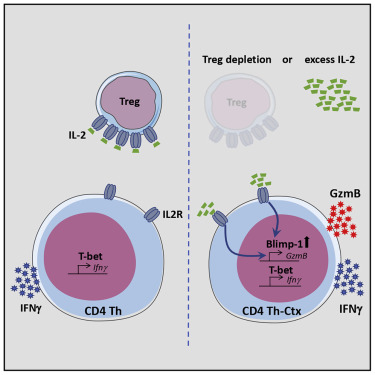Our official English website, www.x-mol.net, welcomes your
feedback! (Note: you will need to create a separate account there.)
Regulatory T Cells Restrain Interleukin-2- and Blimp-1-Dependent Acquisition of Cytotoxic Function by CD4+ T Cells.
Immunity ( IF 25.5 ) Pub Date : 2020-01-07 , DOI: 10.1016/j.immuni.2019.12.007
Anna Śledzińska 1 , Maria Vila de Mucha 2 , Katharina Bergerhoff 1 , Alastair Hotblack 3 , Dafne Franz Demane 1 , Ehsan Ghorani 1 , Ayse U Akarca 4 , Maria A V Marzolini 1 , Isabelle Solomon 1 , Frederick Arce Vargas 1 , Martin Pule 3 , Masahiro Ono 5 , Benedict Seddon 6 , George Kassiotis 7 , Charlotte E Ariyan 8 , Thomas Korn 9 , Teresa Marafioti 4 , Graham M Lord 10 , Hans Stauss 6 , Richard G Jenner 11 , Karl S Peggs 1 , Sergio A Quezada 1
Immunity ( IF 25.5 ) Pub Date : 2020-01-07 , DOI: 10.1016/j.immuni.2019.12.007
Anna Śledzińska 1 , Maria Vila de Mucha 2 , Katharina Bergerhoff 1 , Alastair Hotblack 3 , Dafne Franz Demane 1 , Ehsan Ghorani 1 , Ayse U Akarca 4 , Maria A V Marzolini 1 , Isabelle Solomon 1 , Frederick Arce Vargas 1 , Martin Pule 3 , Masahiro Ono 5 , Benedict Seddon 6 , George Kassiotis 7 , Charlotte E Ariyan 8 , Thomas Korn 9 , Teresa Marafioti 4 , Graham M Lord 10 , Hans Stauss 6 , Richard G Jenner 11 , Karl S Peggs 1 , Sergio A Quezada 1
Affiliation

|
In addition to helper and regulatory potential, CD4+ T cells also acquire cytotoxic activity marked by granzyme B (GzmB) expression and the ability to promote rejection of established tumors. Here, we examined the molecular and cellular mechanisms underpinning the differentiation of cytotoxic CD4+ T cells following immunotherapy. CD4+ transfer into lymphodepleted animals or regulatory T (Treg) cell depletion promoted GzmB expression by tumor-infiltrating CD4+, and this was prevented by interleukin-2 (IL-2) neutralization. Transcriptional analysis revealed a polyfunctional helper and cytotoxic phenotype characterized by the expression of the transcription factors T-bet and Blimp-1. While T-bet ablation restricted interferon-γ (IFN-γ) production, loss of Blimp-1 prevented GzmB expression in response to IL-2, suggesting two independent programs required for polyfunctionality of tumor-reactive CD4+ T cells. Our findings underscore the role of Treg cells, IL-2, and Blimp-1 in controlling the differentiation of cytotoxic CD4+ T cells and offer a pathway to enhancement of anti-tumor activity through their manipulation.
中文翻译:

调节性 T 细胞抑制 CD4+ T 细胞依赖白细胞介素 2 和 Blimp-1 获得细胞毒性功能。
除了辅助和调节潜力外,CD4+ T 细胞还获得以颗粒酶 B (GzmB) 表达为标志的细胞毒活性以及促进对已形成肿瘤的排斥的能力。在这里,我们研究了免疫治疗后细胞毒性 CD4+ T 细胞分化的分子和细胞机制。 CD4+ 转移至淋巴细胞清除的动物或调节性 T (Treg) 细胞清除可通过肿瘤浸润 CD4+ 促进 GzmB 表达,而白介素 2 (IL-2) 中和可阻止这种情况的发生。转录分析揭示了多功能辅助细胞和细胞毒性表型,其特征是转录因子 T-bet 和 Blimp-1 的表达。虽然 T-bet 消融限制了干扰素-γ (IFN-γ) 的产生,但 Blimp-1 的缺失阻止了响应 IL-2 的 GzmB 表达,这表明肿瘤反应性 CD4+ T 细胞的多功能性需要两个独立的程序。我们的研究结果强调了 Treg 细胞、IL-2 和 Blimp-1 在控制细胞毒性 CD4+ T 细胞分化中的作用,并提供了通过操纵它们来增强抗肿瘤活性的途径。
更新日期:2020-01-07
中文翻译:

调节性 T 细胞抑制 CD4+ T 细胞依赖白细胞介素 2 和 Blimp-1 获得细胞毒性功能。
除了辅助和调节潜力外,CD4+ T 细胞还获得以颗粒酶 B (GzmB) 表达为标志的细胞毒活性以及促进对已形成肿瘤的排斥的能力。在这里,我们研究了免疫治疗后细胞毒性 CD4+ T 细胞分化的分子和细胞机制。 CD4+ 转移至淋巴细胞清除的动物或调节性 T (Treg) 细胞清除可通过肿瘤浸润 CD4+ 促进 GzmB 表达,而白介素 2 (IL-2) 中和可阻止这种情况的发生。转录分析揭示了多功能辅助细胞和细胞毒性表型,其特征是转录因子 T-bet 和 Blimp-1 的表达。虽然 T-bet 消融限制了干扰素-γ (IFN-γ) 的产生,但 Blimp-1 的缺失阻止了响应 IL-2 的 GzmB 表达,这表明肿瘤反应性 CD4+ T 细胞的多功能性需要两个独立的程序。我们的研究结果强调了 Treg 细胞、IL-2 和 Blimp-1 在控制细胞毒性 CD4+ T 细胞分化中的作用,并提供了通过操纵它们来增强抗肿瘤活性的途径。







































 京公网安备 11010802027423号
京公网安备 11010802027423号